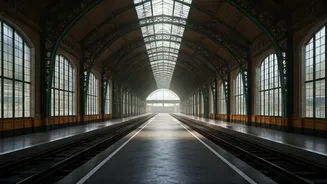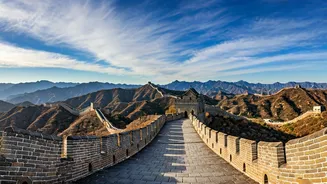Introduction: Journey Begins
India's railway system, a vast and intricate network, isn't just about transport; it's a showcase of architectural diversity and engineering prowess. Beyond
the mundane, numerous stations stand out, embodying a unique blend of historical significance and modern functionality. This journey will uncover nine extraordinary railway stations, each offering a distinct experience, from the lofty heights of mountainous terrain to the bustling heart of cultural hubs. The selection highlights their geographical uniqueness, historical relevance, and the awe-inspiring elements that render each station noteworthy. These stations showcase how India’s infrastructure mirrors its diverse cultural heritage and geographical landscapes.
Darjeeling Himalayan Railway
Nestled in the foothills of the Himalayas, the Darjeeling Himalayan Railway is a UNESCO World Heritage site and a true marvel of engineering. The railway, affectionately known as the 'Toy Train,' meanders through picturesque landscapes, offering breathtaking views of tea gardens and snow-capped peaks. The journey itself is an experience, with the train chugging along at a leisurely pace, allowing passengers to fully absorb the stunning scenery. Built during the British Raj, the railway line is a testament to the ingenuity and perseverance of the engineers who overcame challenging terrain to connect the remote hill station of Darjeeling. Today, it remains a symbol of Darjeeling's charm, attracting tourists from around the globe who come to experience the unique journey.
Ghoom Railway Station
At an elevation of 7,407 feet, Ghoom Railway Station holds the distinction of being India's highest railway station. Located in West Bengal, it forms a crucial part of the Darjeeling Himalayan Railway. The station is a significant stop on the Toy Train route, offering passengers a chance to step out and appreciate the panoramic views of the surrounding mountains. The station’s charm lies in its simplicity and its ability to transport travelers to another era. The cool mountain air and the views of the landscape create an immersive experience. Ghoom is not just a transit point; it's a destination where one can pause, breathe in the mountain air, and absorb the history and natural beauty.
Charbagh Railway Station
Charbagh Railway Station in Lucknow, Uttar Pradesh, is celebrated for its architectural beauty and the artistic concept behind its design. The station’s name, meaning 'garden with four gardens,' reflects its design, which integrates gardens into its layout. Constructed during the British era, the station presents an elegant blend of architectural styles, including Mughal and British influences. From an aerial view, the station appears to resemble a palace. The gardens once enhanced the station’s ambiance, offering a tranquil space amid the hustle and bustle of railway travel. Charbagh showcases how railway stations can be designed not only for functionality but also for aesthetics, enhancing the passenger experience.
Chhatrapati Shivaji Maharaj
Chhatrapati Shivaji Maharaj Terminus (formerly Victoria Terminus) in Mumbai is another UNESCO World Heritage site, renowned for its Victorian Gothic architecture. This iconic railway station, designed by Frederick William Stevens, is a masterpiece of architectural design, blending influences from Italian Gothic and traditional Indian styles. The station’s intricate carvings, soaring arches, and stained-glass windows are testaments to the skill of the artisans who built it. More than a transport hub, it's a symbol of Mumbai's rich history and colonial past. Every detail, from the gargoyles to the domes, tells a story. Today, it is a bustling hub, with thousands of commuters passing through its gates daily, yet its architectural splendor remains.
Howrah Junction Station
Howrah Junction, located in Kolkata, West Bengal, is one of the busiest railway stations in India and is an important transportation hub. This station plays a pivotal role in connecting various parts of India. The architecture is a blend of colonial and modern styles, with a large, imposing structure. Howrah station's location on the banks of the Hooghly River adds to its significance. This station witnesses thousands of passengers daily, making it a critical hub. The sheer scale and continuous movement of people create a dynamic atmosphere. Modernizations have been introduced to make the station efficient, all while preserving its historical legacy.
Chennai Central Station
Chennai Central Station, in Tamil Nadu, stands as a grand example of colonial-era architecture. This significant railway station is notable for its impressive facade and strategic importance in connecting South India. The station's design features elements of Gothic and Romanesque styles. Its towering structure, with its iconic clock tower, is a landmark in Chennai. The building's red brick construction stands out, illustrating the colonial influence. The station serves as a crucial transit point for travelers. Chennai Central has been an integral part of the city’s identity, witnessing significant historical events and accommodating millions of passengers.
Kalka-Shimla Railway
The Kalka-Shimla Railway is a narrow-gauge railway line that is another UNESCO World Heritage site, famous for its scenic journey through the Himalayas. The route is filled with tunnels and bridges, as the train climbs through the mountains, providing passengers with stunning views of the surrounding landscapes. The railway line, constructed during the British era, is a marvel of engineering, overcoming the challenges of steep inclines and difficult terrains. The journey offers breathtaking vistas of pine-covered hills, quaint villages, and deep valleys. The train’s slow speed allows passengers to savor every moment, creating a memorable travel experience. This train is more than a mode of transport; it's a journey through history.
Varanasi Junction Station
Varanasi Junction, located in Uttar Pradesh, is a significant railway station for pilgrims and tourists visiting the holy city of Varanasi. The station sees a high volume of traffic due to its importance. The station has a blend of functional and modest architecture, serving the need of millions of passengers who visit the city every year. With its strategic location, it is a key entry point for travelers. Over time, the station has been upgraded to enhance passenger amenities. It connects Varanasi, a city with deep spiritual significance, to the rest of India. The station has a distinct identity in the heart of the ancient city, maintaining its importance to both local residents and tourists.
Jammu Tawi Railway
Jammu Tawi Railway Station, located in Jammu and Kashmir, is a significant station connecting the region to the rest of India. The station serves as a crucial entry point for tourists. Its architectural style is influenced by the region's cultural heritage, providing a sense of place for travelers. The station’s location offers views of the surrounding mountains and valleys. It has undergone various upgrades. The station plays an essential role in trade and tourism. It serves as a vital link, bridging the city with the national railway network, playing an important role in connecting the region and welcoming travelers.













